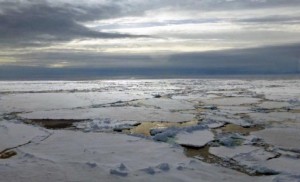12 July 2014, by Matt Shupe, [82N, 102E]:
Why are we here? I guess after a few entries and a week underway it would make sense to spell out why we have actually come to the Arctic (beyond the simple fascination of the whole experience!). In short, we are here to study the clouds and the environmental system in which they reside. In particular, we are interested in how the clouds and atmosphere interact with the surface, which here is a mixture of open water and sea ice. By definition, ice is at or below the freezing point, while liquid water is at or above this transition temperature. Thus the different surface types can have different influences on the amount of heat (and moisture) that is transferred upward to the atmosphere…. potentially influencing clouds. Our cruise track will go in and out of the ice pack, and along this course we will document the clouds and atmosphere.
Our project is called the Arctic Clouds in Summer Experiment (ACSE). It is a 3-way collaboration between the universities of Stockholm, Leeds (UK), and Colorado born out of previous collaborative expeditions, such as the Arctic Summer Cloud-Ocean Study (ASCOS). Each institute brings important contributions in terms of instruments, funding, expertise, and research. ASCOS, in 2008, was very successful in producing high-quality measurements near the North Pole and our team has published many resulting papers. Thus, we have high expectations for our current adventure.
ACSE is but a small part of the larger expedition on Oden called SWERUS-C3. For us atmospheric scientists it is a cruise-of-opportunity that became available via our collaborator, Michael Tjernström’s connections with the SWERUS organizers. We have been given five berths on the ship and plenty of space for our equipment, which generally occupies different space from the rest of the expedition. We are interested in looking up at the sky. SWERUS-ians on the other hand generally look downward. They study the carbon system, including sub-sea permafrost, sea-floor sediment, methane emissions, and many related processes. At a fundamental level, they are motivated by the potential release of vast reservoirs of carbon (methane) stored under the Siberian shelf as the permafrost thaws. This area is the largest ocean shelf in the world, sitting under the Arctic Ocean just north of Siberia. A vast swath of relatively shallow waters that covers a landmass that not so long ago was exposed to the air. Its carbon stores originated from before it became submerged, and also from sediment that is washed out of the major rivers draining into the Arctic Ocean. Much of the shelf is frozen – permafrost – under the ocean, as it takes millennia for the frozen land to thaw in the presence of waters that are very near the freezing point themselves yearround. I find this to be a fascinating system, with potentially dramatic implications for our changing globe….. and I am rather ignorant of the processes involved (the previous sentences being just about all I know!) Thus, this has been, and will continue to be, a great opportunity for me to learn about a new field of study.

